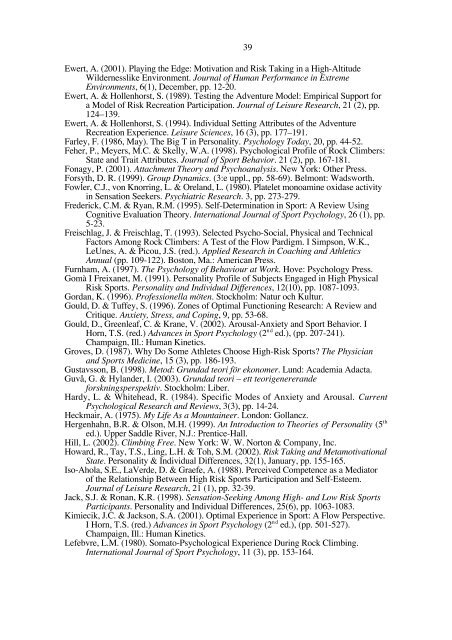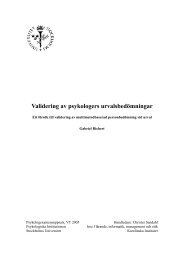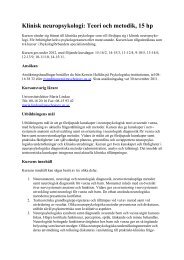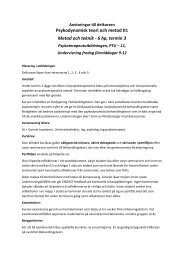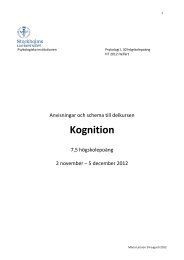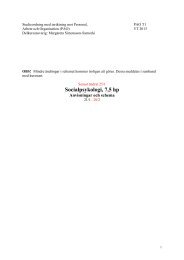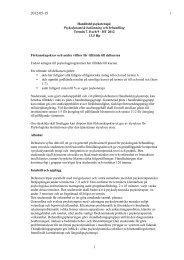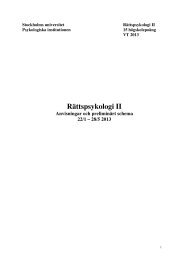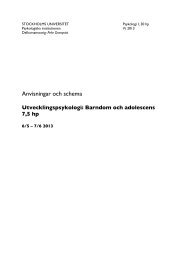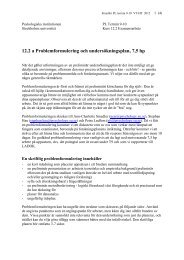PSYKOLOGISKA INSTITUTIONEN - Stockholms universitet
PSYKOLOGISKA INSTITUTIONEN - Stockholms universitet
PSYKOLOGISKA INSTITUTIONEN - Stockholms universitet
Create successful ePaper yourself
Turn your PDF publications into a flip-book with our unique Google optimized e-Paper software.
Ewert, A. (2001). Playing the Edge: Motivation and Risk Taking in a High-Altitude<br />
Wildernesslike Environment. Journal of Human Performance in Extreme<br />
Environments, 6(1), December, pp. 12-20.<br />
Ewert, A. & Hollenhorst, S. (1989). Testing the Adventure Model: Empirical Support for<br />
a Model of Risk Recreation Participation. Journal of Leisure Research, 21 (2), pp.<br />
124–139.<br />
Ewert, A. & Hollenhorst, S. (1994). Individual Setting Attributes of the Adventure<br />
Recreation Experience. Leisure Sciences, 16 (3), pp. 177–191.<br />
Farley, F. (1986, May). The Big T in Personality. Psychology Today, 20, pp. 44-52.<br />
Feher, P., Meyers, M.C. & Skelly, W.A. (1998). Psychological Profile of Rock Climbers:<br />
State and Trait Attributes. Journal of Sport Behavior. 21 (2), pp. 167-181.<br />
Fonagy, P. (2001). Attachment Theory and Psychoanalysis. New York: Other Press.<br />
Forsyth, D. R. (1999). Group Dynamics. (3:e uppl., pp. 58-69). Belmont: Wadsworth.<br />
Fowler, C.J., von Knorring, L. & Oreland, L. (1980). Platelet monoamine oxidase activity<br />
in Sensation Seekers. Psychiatric Research. 3, pp. 273-279.<br />
Frederick, C.M. & Ryan, R.M. (1995). Self-Determination in Sport: A Review Using<br />
Cognitive Evaluation Theory. International Journal of Sport Psychology, 26 (1), pp.<br />
5-23.<br />
Freischlag, J. & Freischlag, T. (1993). Selected Psycho-Social, Physical and Technical<br />
Factors Among Rock Climbers: A Test of the Flow Pardigm. I Simpson, W.K.,<br />
LeUnes, A. & Picou, J.S. (red.). Applied Research in Coaching and Athletics<br />
Annual (pp. 109-122). Boston, Ma.: American Press.<br />
Furnham, A. (1997). The Psychology of Behaviour at Work. Hove: Psychology Press.<br />
Gomà I Freixanet, M. (1991). Personality Profile of Subjects Engaged in High Physical<br />
Risk Sports. Personality and Individual Differences, 12(10), pp. 1087-1093.<br />
Gordan, K. (1996). Professionella möten. Stockholm: Natur och Kultur.<br />
Gould, D. & Tuffey, S. (1996). Zones of Optimal Functioning Research: A Review and<br />
Critique. Anxiety, Stress, and Coping, 9, pp. 53-68.<br />
Gould, D., Greenleaf, C. & Krane, V. (2002). Arousal-Anxiety and Sport Behavior. I<br />
Horn, T.S. (red.) Advances in Sport Psychology (2 nd ed.), (pp. 207-241).<br />
Champaign, Ill.: Human Kinetics.<br />
Groves, D. (1987). Why Do Some Athletes Choose High-Risk Sports The Physician<br />
and Sports Medicine, 15 (3), pp. 186-193.<br />
Gustavsson, B. (1998). Metod: Grundad teori för ekonomer. Lund: Academia Adacta.<br />
Guvå, G. & Hylander, I. (2003). Grundad teori – ett teorigenererande<br />
forskningsperspektiv. Stockholm: Liber.<br />
Hardy, L. & Whitehead, R. (1984). Specific Modes of Anxiety and Arousal. Current<br />
Psychological Research and Reviews, 3(3), pp. 14-24.<br />
Heckmair, A. (1975). My Life As a Mountaineer. London: Gollancz.<br />
Hergenhahn, B.R. & Olson, M.H. (1999). An Introduction to Theories of Personality (5 th<br />
ed.). Upper Saddle River, N.J.: Prentice-Hall.<br />
Hill, L. (2002). Climbing Free. New York: W. W. Norton & Company, Inc.<br />
Howard, R., Tay, T.S., Ling, L.H. & Toh, S.M. (2002). Risk Taking and Metamotivational<br />
State. Personality & Individual Differences, 32(1), January, pp. 155-165.<br />
Iso-Ahola, S.E., LaVerde, D. & Graefe, A. (1988). Perceived Competence as a Mediator<br />
of the Relationship Between High Risk Sports Participation and Self-Esteem.<br />
Journal of Leisure Research, 21 (1), pp. 32-39.<br />
Jack, S.J. & Ronan, K.R. (1998). Sensation-Seeking Among High- and Low Risk Sports<br />
Participants. Personality and Individual Differences, 25(6), pp. 1063-1083.<br />
Kimiecik, J.C. & Jackson, S.A. (2001). Optimal Experience in Sport: A Flow Perspective.<br />
I Horn, T.S. (red.) Advances in Sport Psychology (2 nd ed.), (pp. 501-527).<br />
Champaign, Ill.: Human Kinetics.<br />
Lefebvre, L.M. (1980). Somato-Psychological Experience During Rock Climbing.<br />
International Journal of Sport Psychology, 11 (3), pp. 153-164.<br />
39


